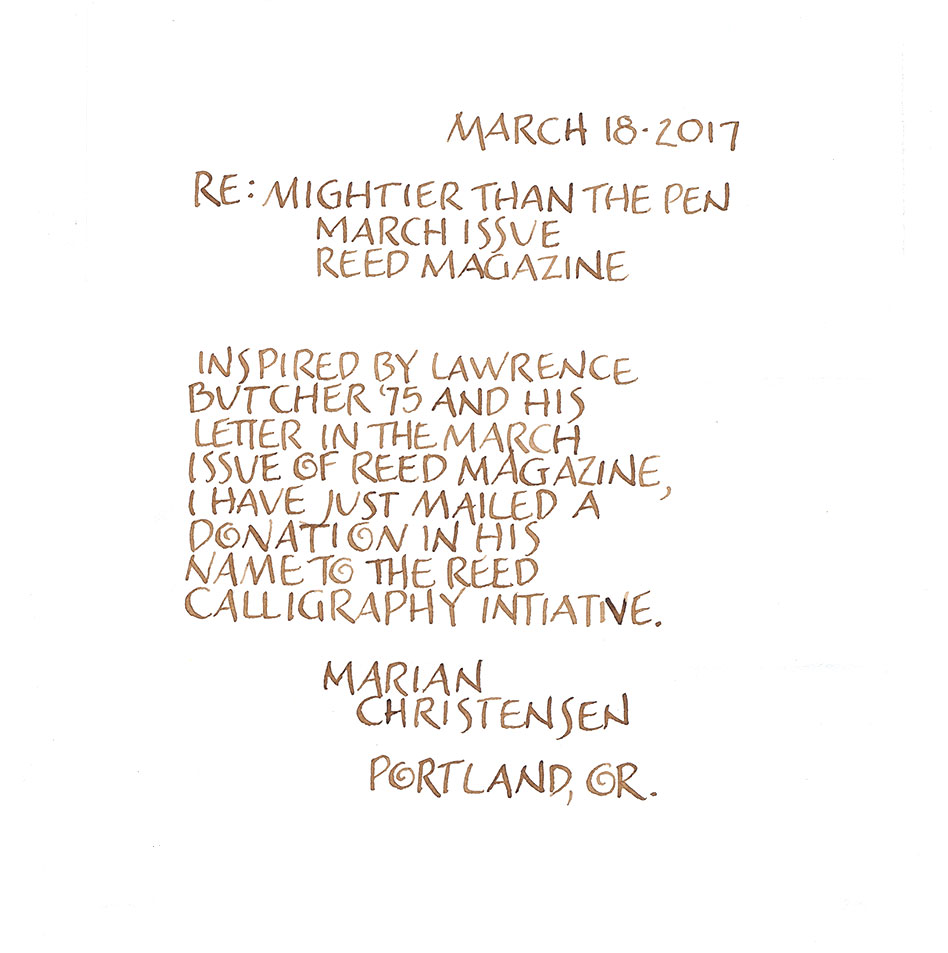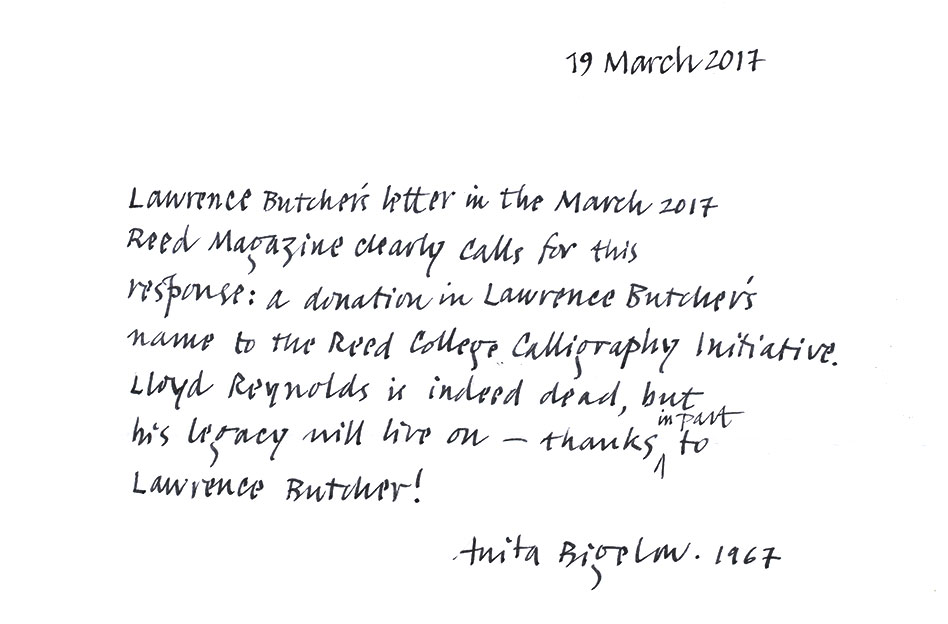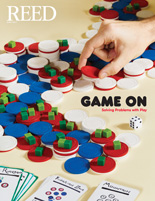
IRIS login | Reed College home Volume 96, No. 2: June 2017
Calligraphy

Many thanks to Lawrence Butcher ’75 for his critique of formal handwriting (Letters, March 2017), though I do think deluded self-appreciation and lack of redeeming social value are not unique to calli-
graphy. What is unique is the economy of effort traditional writing affords to low-tech recorded speech. Audio engineers are the contemporary equivalent. The handwritten letter is a couture response to content, and it ain’t necessarily the ruffles and flourishes writing masters used to lure students after Gutenberg automated their game. The pen point is the exact equivalent of the cutting stylus on a master recording device. Working consciously since 1952, I comprehend a writing tool as a musical instrument that can be played silently under any circumstances and writing itself as a subtly percussive exercise.
Speed is a legitimate variable related to content. Traditional scripts remain legible when they decay under pressure of production. The content of a trained scrawl can be retrieved by repeating the gestures of the writer. The traditional sequence and direction of writing strokes are simple to learn and most valuable when circumstances are most demanding. Consider communicating with lumber crayon on the side of a building after a natural disaster: a decipherable message may be the only connection to one’s personal future. Renaissance italic military orders are far more legible than 19th-century copperplate commands.
Faces and fonts are successive applications of the original written forms that are embedded in each iteration. Roman letters descend from handwritten models that evolved under varying cultural circumstances and are the oldest uninterrupted system of graphic indication available to humanity.
I have enjoyed my share of letters that looked like waltzing pigs, but I have never seen a student who could be described as one. Thanks again for supplying the disdain that has been a crucial element of the calligraphic revival since its inception in the 19th century. Working with letterforms without knowing their history is like practicing medicine without knowing anatomy.
Chris Emerson ’66
Seattle, Washington

我
Wyn Berry ’57
Vashon, Washington
I understand Lawrence Butcher’s frustration with Lloyd Reynolds as a Reed superhero. I too began at Reed after Lloyd’s tenure, which ended in 1969. A while back, curious as to his popularity with Reed Magazine, I googled Lloyd to see what the fuss was all about. I can understand the fuss. Lloyd’s classes, available on YouTube, present a way of engaging with history from a vocational perspective. Writing was a privilege in the old days, and Lloyd’s classes remind us of that.
As for calligraphy being dead, the artistic value of the script one uses is as current now as it was then. Steve Jobs, in his commencement address to Stanford students, said it was the calligraphy at Reed that was partially responsible for him producing computers: “Throughout the campus, every poster, every label on every drawer, was beautifully hand calligraphed.” And while Jobs was at Reed after Reynolds, he probably dropped in on the calligraphy class of Robert Palladino [art 1969–84], Reynolds’s protégé: “I learned about serif and sans serif typefaces, about varying the amount of space between different letter combinations, about what makes great typography great. It was beautiful, historical, artistically subtle in a way that science can’t capture, and I found it fascinating.”
Combine the importance of writing with a well-informed and gentle approach, and one can see the appeal of Reynolds’s classes. Far from being irrelevant, asking why Lloyd Reynolds is relevant to Reed is as Reed as Reed gets. Good question.
Bill Owen ’84
Beaverton, Oregon
拉
Charles Bigelow ’67
Rochester, New York
I was pleasantly surprised to discover Lawrence Butcher’s criticism of Lloyd Reynolds in the March Reed Magazine. I had thought Lloyd’s reputation was so well established that he was beyond criticism. I took an art appreciation class from Lloyd in 1954. His theory was that art appreciation was all about lines, shapes, and balance—left-brain concepts. I thought then— and still do—that art appreciation is about what feelings the work expresses or what feelings the work intends the audience to feel. So in the major project to analyze 10 works of art, I discussed feelings. Lloyd gave me a D for the course. Such respect for an alternate point of view!
But Lloyd was simply expressing what is wrong with Reed—the hopeless overemphasis on the left brain. The class of 1957 had 250 freshmen, and 73 of us graduated. Why? Because so many of us were emotional messes, even worse than me, who primarily majored in poker. Where does Reed feed our right brains? I’ve always thought that Reed needs something in the way of emotional support groups or encounter groups required of all students. As for Lawrence Butcher, because of his left-brain-only training, he doesn’t notice that calligraphy is beautiful.
Don Schuman ’57
Bend, Oregon
I was a bit puzzled by the letter from Mountain View that complained about the abundance of calligraphy. How can that even be offensive? At a recent visit to the newly refurbished Portland Japanese Gardens, I read about the samurai’s respect for the Bunbu-Ryodo, the Twofold Path of the Sword and the Pen. I wanted to share an excerpt here: “To acquire the inner strength needed to succeed, a warrior needed not only skill in the martial arts, but also in the cultured arts of tea ceremony, poetry writing and calligraphy–all influenced by the disciplined practice of Zen Buddhism.”

LATEST COMMENTS
steve-jobs-1976 I knew Steve Jobs when he was on the second floor of Quincy. (Fall...
Utnapishtim - 2 weeks ago
Prof. Mason Drukman [political science 1964–70] This is gold, pure gold. God bless, Prof. Drukman.
puredog - 1 month ago
virginia-davis-1965 Such a good friend & compatriot in the day of Satyricon...
czarchasm - 4 months ago
John Peara Baba 1990 John died of a broken heart from losing his mom and then his...
kodachrome - 7 months ago
Carol Sawyer 1962 Who wrote this obit? I'm writing something about Carol Sawyer...
MsLaurie Pepper - 8 months ago
William W. Wissman MAT 1969 ...and THREE sisters. Sabra, the oldest, Mary, the middle, and...
riclf - 10 months ago